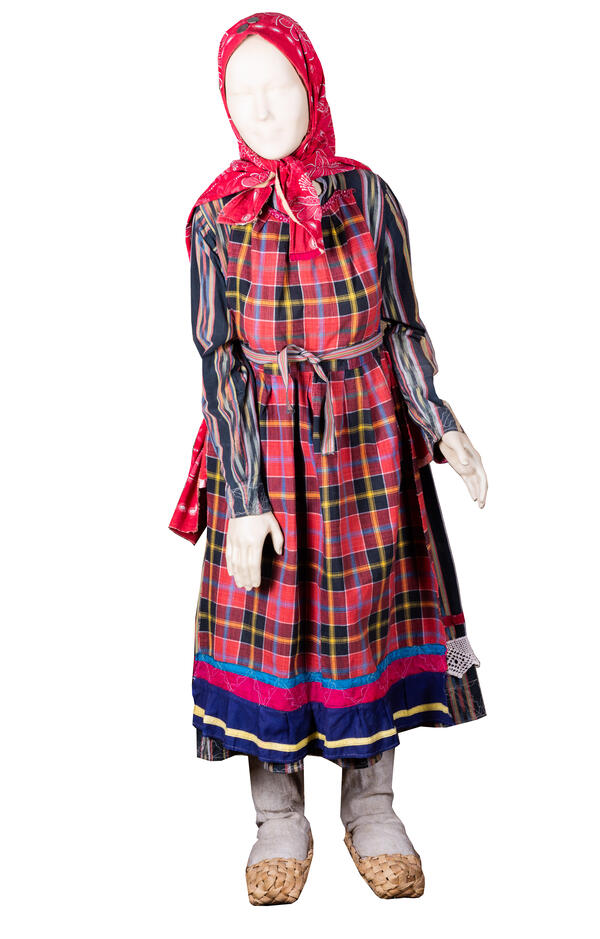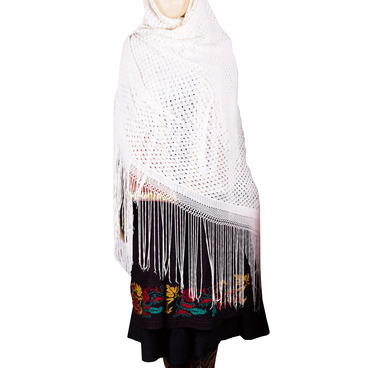The traditional Udmurt national costume was not only ornamentation for its owner, but was also a symbolic covering that helped protect from troubles from the outside environment. The most ancient Udmurt clothing had a style similar to modern tunics — it was loose clothing that covered the whole body in the form of a bag with holes for the head and hands. The Udmurt people wove the materials to sew clothing by hand — in the north they used flax, and in the south they used hemp. Animal husbandry allowed the Udmurts to use sheep wool as a raw material for fabrics. In the exposition housed at the Ethnography Hall, along with bast shoes there is a traditional southern Udmurt dress called a shortdarem — an elegant female trapezoidal dress made of homespun woolen fabric.
The color scheme for the national Udmurt costume consists of white, gray, brown, and red coloring, as well as ocher and indigo. Udmurt artisans obtained dyes from minerals and plants, and over time they began to use aniline dyes, which were brought in by the Turks that traded with Udmurtia. It is worth noting that in the northern Udmurt regions clothes were decorated more modestly, and white and gray colors predominated in their designs. In southern regions, the colors were more variegated and saturated: this is due to the location of the trading routes, which were in much more abundance in the southern part of Udmurtia.
With the advent of satin and silk fabrics, Udmurt seamstresses began to sew elegant shirts and dresses from them. Girls who knew not only to weave and sew, but also had good artistic sense, could rightfully be called fashion designers in their time: by creating an outfit that had a new style, they marked it with a special designer’s label, such as a bundle of threads. Other seamstresses might copy an original costume, but with the help of a label they could also place emphasis on who designed it.
Over time, the national Udmurt costume began to wane in popularity, and homespun fabrics were gradually replaced by factory-made ones. This took place in the post-Second World War years, when people began to pay for labor with cash instead of bartering for it with goods. During this period, handicrafts ceased to be in demand, and were considered a sign that a family was not well-off. Despite this, homespun cloth pieces have been preserved in many Udmurt homes, and by now have gained some historical value.
The color scheme for the national Udmurt costume consists of white, gray, brown, and red coloring, as well as ocher and indigo. Udmurt artisans obtained dyes from minerals and plants, and over time they began to use aniline dyes, which were brought in by the Turks that traded with Udmurtia. It is worth noting that in the northern Udmurt regions clothes were decorated more modestly, and white and gray colors predominated in their designs. In southern regions, the colors were more variegated and saturated: this is due to the location of the trading routes, which were in much more abundance in the southern part of Udmurtia.
With the advent of satin and silk fabrics, Udmurt seamstresses began to sew elegant shirts and dresses from them. Girls who knew not only to weave and sew, but also had good artistic sense, could rightfully be called fashion designers in their time: by creating an outfit that had a new style, they marked it with a special designer’s label, such as a bundle of threads. Other seamstresses might copy an original costume, but with the help of a label they could also place emphasis on who designed it.
Over time, the national Udmurt costume began to wane in popularity, and homespun fabrics were gradually replaced by factory-made ones. This took place in the post-Second World War years, when people began to pay for labor with cash instead of bartering for it with goods. During this period, handicrafts ceased to be in demand, and were considered a sign that a family was not well-off. Despite this, homespun cloth pieces have been preserved in many Udmurt homes, and by now have gained some historical value.



